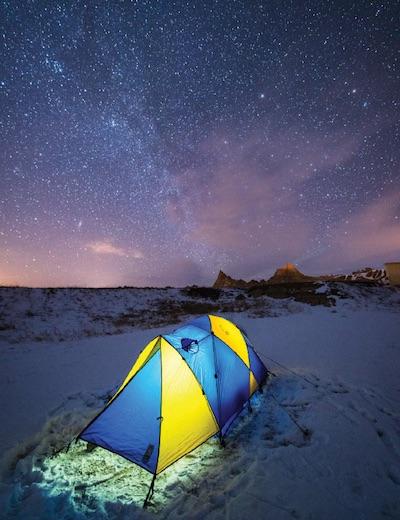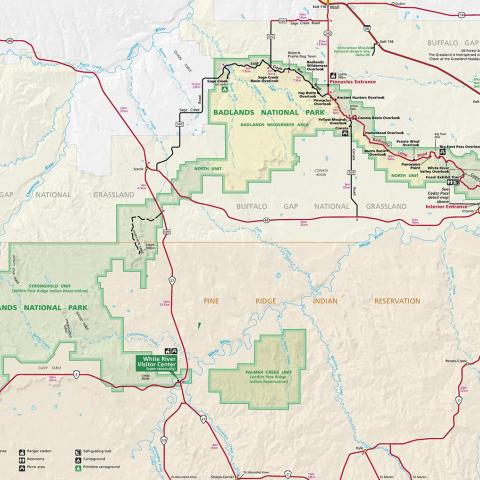Otherworldly. The spires, buttes, and indescribable angles on badlands formations that rose inexplicably out of the flat plains caught my attention, but it was the weather that felt otherworldly. All night long winds shook my tent as I shivered in a 0° sleeping bag covered by a 30° sleeping bag. Despite the sub-zero temps, by noon the thermometer in my car read 50°. Fifty wasn’t what I was expecting for winter temperatures in Badlands National Park.
According to the National Park Service, moist air from the Pacific Ocean travels east to the Rockies, where it rises over the mountains. As it rises, the moisture precipitates as snow. When the now dry air descends the eastern slopes of the Rockies, it warms and travels to the Black Hills and Badlands. It keeps the area warmer than other parts of South Dakota and the Midwest and creates a banana belt.
When I had arrived late the evening before it felt nothing like a banana belt. I set up my tent in the group campground, the only open campground during the winter, while wearing two down coats and almost all the clothing I brought. It was my second visit to the park during this winter, and I really wanted to photograph snow on the formations. I wanted the contrast between the white snow, the browns, and amber browns of the formations with a colorful sunrise or sunset above the scene. I hadn’t gotten the shots I wanted on that first visit when it was 50s and 60s all week, and it wasn’t looking like I would get what I wanted on this visit if the temps were to continue rising.
By the afternoon, it was snowing again. After photographing bison in the snow, I crashed in my tent.

Bison don't mind the winter weather at Badlands National Park. At least, they don't seem to/Bryan Hansel
Badlands National Park in South Dakota is about an hour east of the Black Hills and Rapid City. Its 244,000 acres protect a mixed-grass prairie and 26- to 75-million-year-old sediment eroded into spires, buttes and rugged cliffs. It also contains one of the richest fossil beds in the world. Almost any hike into the formations yields a fossil. The park instructs you to leave them in place and report your finds. On my first, we found a skull, a leg bone of a 35-million-year-old horse-like mammal, and an almost complete tortoise with leg and neck bones sticking out of its shell. We reported our finds and later heard back about what animals they were from.
The park itself is divided into several units. The North Unit is the most popular. It’s popular because it’s close to the Interstate and it has a road, the Badlands Loop Road, running straight through it. The Stronghold Unit located within Pine Ridge Indian Reservation has no roads and Palmer Creek Unit is surrounded by private property. The ease of access to the North Unit makes it the most popular and usually the busiest.

Winter's get extremely cold at Badlands National Park, but also extremely gorgeous/Bryan Hansel
Despite the otherworldly weather, there are advantages in visiting the Badlands in the winter. Because winter visitation is so low, you’re likely only to see the rangers and maybe one or two people passing through on the road. In summer, you’d be lucky to have an overlook to yourself. In the winter, you could sit at an overlook all day and not see anyone. With such light traffic on the road, the animals come out from hiding. It’s easy to spot bison, bighorn sheep, mule deer, rabbits, prairie dogs, and even an occasional coyote. In summer during the busy months, you probably won’t see anything other than bison. The best reason for visiting in winter is that the sunrises and sunsets line up with the badland formations and the overlooks in the northern unit better than any other time of the year.
In the morning, I opened my tent’s door to more otherworldly weather. Thick fog. There would be no sunrise to photograph. After getting up, I drove the Badlands Loop Road west from the campground and stopped in the fog now and then to take a picture of a formation in the whiteout. It was hard to see anything in the distance, but bison near the road made good subjects. By the time I reached the end of the road, it looked like the fog might lift. I proceeded onto Sage Creek Road, a gravel road that reaches into the wilderness section of the park. At noon, I made it to Hay Butte Overlook just as the fog lifted. In the distance, the badland formations covered with a dusting of snow stood out against the clearing fog and newly revealed blue sky.
By late afternoon, the temps reached back into the 60s and the snow was melting quickly. I tried to get a picture of the snow before it melted away completely from the top of Saddle Pass, a steep historic pass that settlers used to get from the lower sections of the Badlands to the flats above it. But, despite looking dry on the surface, the clay making up the formations was wet underneath. After a fruitless 10 minutes, I understood the literal meaning of one step forward and two steps backwards. I made it made 30 feet up the pass before turning around with shoes that weighed a ton from the caked-on mud.
For sunset, I went to Pinnacles Overlook, one of the most scenic overlooks in the park. While balanced on the side of a formation, I watched as the sky turned the same reddish mud color of the formations. The leftover snow set off the patterns of the 26+-million-year-old sediment and I felt giddy while taking the shot. Everything had lined up perfectly for the shot I had wanted. While I had suffered through two days of 60- to 70-degree temperature swings, it was all worth it when I saw the result. The otherworldly weather paid off.
For more photos, see the article in our Essential Park Guide, Winter 2015-16.






 Support Essential Coverage of Essential Places
Support Essential Coverage of Essential Places







Add comment